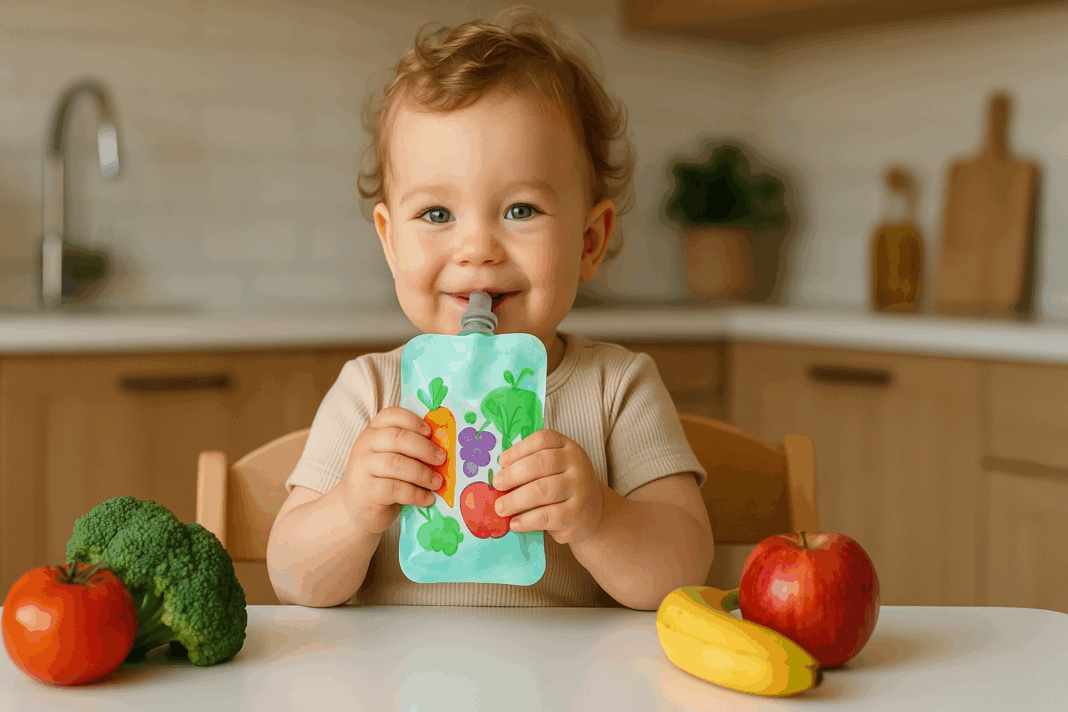In today’s health-conscious parenting landscape, caregivers are increasingly turning to innovative, child-friendly options that promote both nutrition and convenience. Among the most popular solutions are drinkable pouches, especially formulated to deliver hydration and nutrients in a form that toddlers can enjoy and parents can trust. As toddlers transition from breastfeeding or bottle-feeding to more independent eating and drinking habits, their fluid intake becomes a vital component of overall wellness. Choosing the best pouches for toddlers to support healthy hydration is more than a matter of convenience—it’s a decision that has long-term implications for their nutritional development and daily wellbeing. By understanding the nutritional content, packaging safety, flavor appeal, and practical considerations of these pouches, parents can confidently navigate a growing market of options to find the best solutions for their child’s needs.
You may also like: The Ultimate Guide to Choosing the Best Sippy Cup for Healthy Hydration and Growing Kids

Understanding the Importance of Hydration in Toddlers
Hydration is a cornerstone of healthy growth during early childhood. For toddlers, who are typically between the ages of one and three, staying hydrated supports a wide range of bodily functions including temperature regulation, digestion, nutrient absorption, and brain development. Unlike older children or adults, toddlers may not always recognize or express feelings of thirst, making it essential for parents and caregivers to proactively offer fluids throughout the day. The consequences of even mild dehydration in young children can manifest quickly, often as irritability, fatigue, dry skin, or constipation.
In this stage of rapid development, toddlers require an average of four to five cups of fluids per day, with water and milk being primary sources. However, lifestyle factors such as daycare routines, outdoor play, and finicky appetites can make it challenging to meet these daily hydration needs consistently. This is where toddler-friendly pouches come into play. By offering an appealing, easy-to-handle format that combines hydration with potential nutritional benefits, the best pouches for toddlers serve as both a practical solution and a proactive measure for maintaining wellness.
Beyond simply quenching thirst, fluids consumed through pouches can also deliver essential electrolytes, vitamins, and minerals. These additional nutrients are particularly important for toddlers experiencing periods of illness, teething discomfort, or hot weather exposure, all of which can increase the risk of dehydration. Thoughtfully designed pouches thus serve not only to hydrate but also to nourish, creating a synergy that aligns with the broader goals of child development and health.
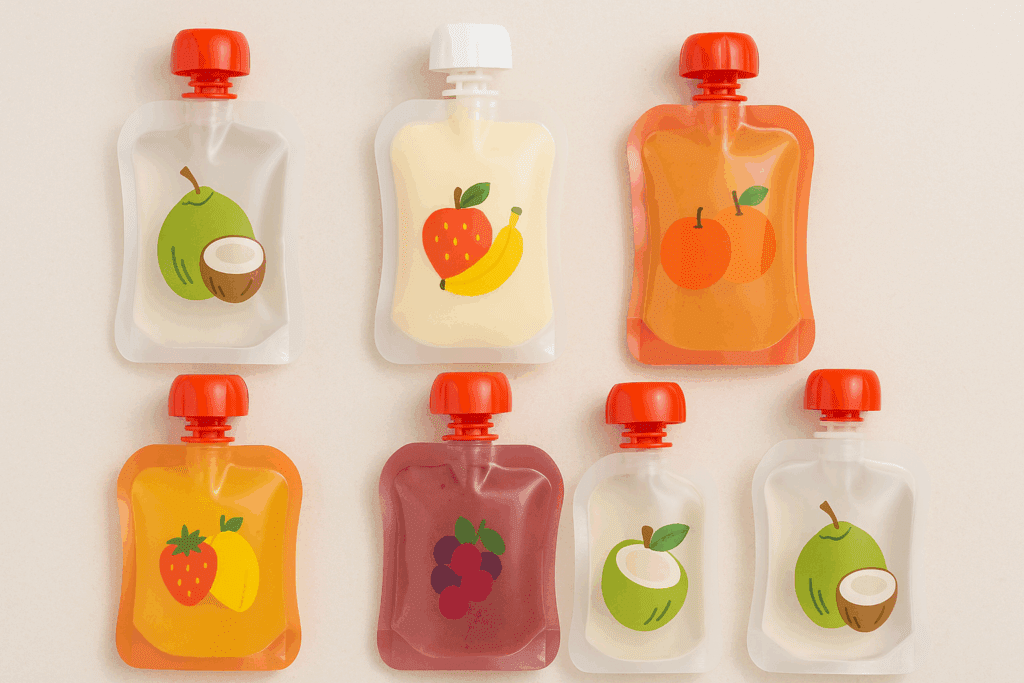
What Makes a Toddler Pouch Ideal for Hydration?
Identifying the best baby pouches or toddler drink pouches begins with understanding the core characteristics that make a product effective and trustworthy. One of the primary features is the liquid base—typically water, coconut water, or milk—each with unique benefits. Water-based pouches provide pure hydration without unnecessary additives, while coconut water naturally includes potassium and magnesium, important electrolytes that support muscle function and nerve signaling. Milk-based options, often found in smoothie-style pouches, offer protein, calcium, and vitamin D, supporting bone growth and satiety.
Another critical factor is the inclusion (or exclusion) of added sugars. While natural fruit sugars are generally considered acceptable in moderation, excessive added sugar can lead to blood sugar spikes, dental issues, and poor dietary habits. The American Academy of Pediatrics recommends avoiding added sugars entirely for children under two, and minimizing intake in older toddlers. Parents should examine nutrition labels carefully to distinguish between naturally occurring sugars from fruits and those added during processing.
Flavor and texture also influence the effectiveness of a pouch. Children are more likely to drink fluids they find palatable, and familiar fruit blends like apple-banana or berry-peach often prove successful. However, pouches that offer less common flavor combinations, such as cucumber-melon or mango-spinach, may also be beneficial in expanding a toddler’s palate. Texture matters too—liquids that are too thick may be harder for younger toddlers to consume easily, while overly thin liquids might lack the substance needed to keep a child satisfied between meals.
Packaging plays a surprisingly influential role in both hydration and safety. The best pouches for toddlers are typically BPA-free, use recyclable materials, and feature resealable caps that prevent spills while allowing for portion control. Some pouches are designed with ergonomic shapes or easy-grip materials to support independent use, fostering motor skill development and autonomy. Clear labeling, including transparency about ingredients and sourcing, also boosts parental confidence and supports informed decision-making.

The Rise of On-the-Go Nutrition and Hydration
In a world where family schedules are increasingly fast-paced, convenience has become a key factor in consumer choice. Pouches provide an exceptional blend of portability and nutritional reliability that busy parents find invaluable. Whether at the park, in the car, or during a playdate, pouches eliminate the need for cups, straws, or refrigeration, making them a hassle-free option that fits seamlessly into modern routines. The shift toward on-the-go hydration also reflects broader societal changes, including the rise of dual-income households and extended periods in daycare or preschool environments.
From a developmental standpoint, pouches can also empower toddlers to participate in mealtime decisions. Encouraging self-feeding and self-drinking builds confidence and supports fine motor development, both of which are vital milestones during this stage. Choosing the best pouches for toddlers to keep on hand during outings allows parents to support hydration and nutrition without interrupting the child’s natural rhythm of exploration and activity.
Moreover, many manufacturers now prioritize the dual goals of convenience and environmental sustainability. Recyclable or reusable pouch materials reduce waste and teach children the importance of eco-conscious behavior from an early age. Subscription models and multi-pack options also make it easier for families to maintain consistent access to their preferred pouches, minimizing last-minute grocery runs or reliance on less healthy alternatives.
Nutritional Considerations When Selecting the Best Baby Pouches
While hydration remains a central focus, it’s important not to overlook the broader nutritional profile of toddler pouches. Ideally, the best baby pouches should complement—not replace—whole foods like fruits, vegetables, grains, and proteins. They should serve as nutritional allies, not as substitutes for more diverse and textured food experiences.
Macronutrients are a critical consideration. A well-balanced pouch may offer a combination of simple carbohydrates for quick energy, plant-based fats for brain development, and a moderate amount of protein to sustain satiety. Parents should look for pouches that include not only fruits but also vegetables, legumes, or whole grains to increase fiber content and diversify the nutrient base. Ingredients such as chia seeds, oats, or quinoa can enhance the pouch’s nutritional complexity without compromising taste or drinkability.
Micronutrients, including iron, zinc, and vitamin C, are equally vital. Iron supports cognitive development and immune function, while vitamin C enhances iron absorption and acts as a potent antioxidant. Some of the best pouches for toddlers include these vitamins through naturally occurring sources like strawberries, oranges, spinach, or lentils. Fortified options can be helpful, particularly for picky eaters or those with limited dietary variety, but should not be relied upon exclusively.
Food allergies and sensitivities must also be considered. Dairy-free, gluten-free, nut-free, or soy-free options can cater to children with known intolerances or family histories of allergic reactions. Carefully reading labels for potential allergens, artificial preservatives, and synthetic flavorings helps parents select products that align with their child’s health profile and family values.
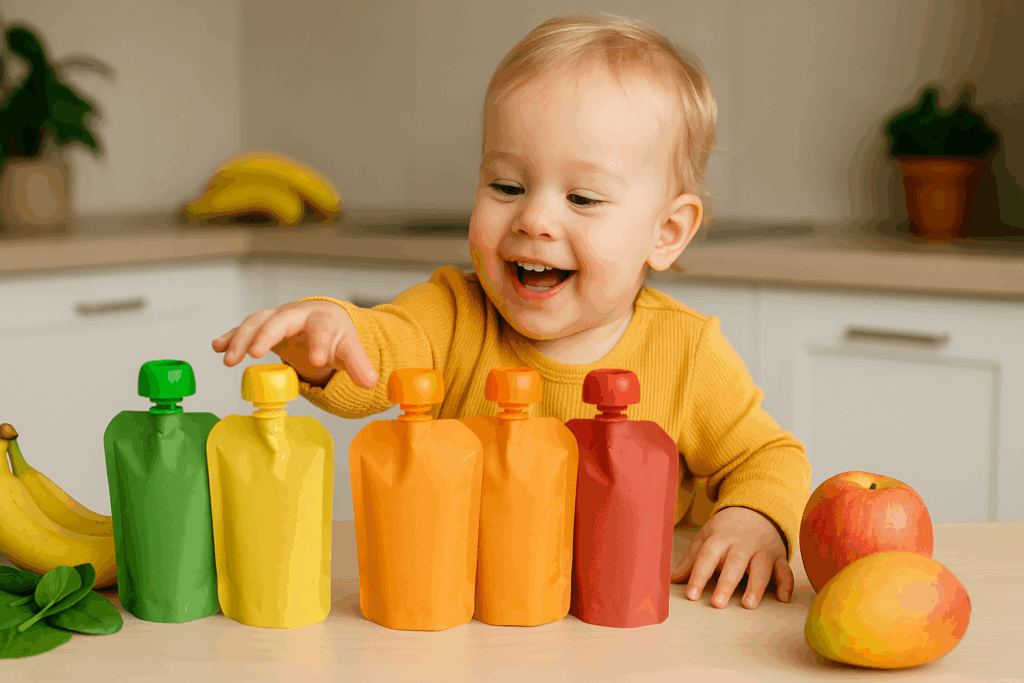
Taste Preferences and Pouch Appeal for Young Children
Understanding what makes a pouch appealing to a toddler goes beyond flavor alone. The sensory experience—smell, texture, visual appeal, and even sound—can influence whether a child will consistently enjoy a particular product. Toddlers are naturally curious but also cautious about unfamiliar foods. This stage is characterized by neophobia, or the fear of trying new things, which can be mitigated by exposure and positive reinforcement.
Flavor layering is an increasingly common strategy in the formulation of the best baby pouches. By combining sweet fruits with neutral or subtly bitter vegetables, manufacturers can introduce complex flavors in a way that feels familiar. For instance, a blend of apple, spinach, and pear may offer sweetness upfront with a mild vegetal aftertaste, encouraging toddlers to accept a broader range of flavors over time.
Color also plays an important role. Brightly colored pouches that mirror the natural colors of fruits and vegetables are more visually appealing and may even stimulate interest in whole-food versions of the ingredients. Transparency in packaging, where parents can see the color and consistency of the product, builds trust and allows for informed decisions about freshness and quality.
The actual design of the pouch itself—cartoon characters, vibrant patterns, or interactive elements like scratch-and-sniff labels—can further enhance appeal. While these features cater more to marketing than nutrition, they do influence a child’s willingness to try and enjoy the product. Ideally, visual design should be paired with strong ingredient integrity so that a parent’s values and a child’s preferences can meet harmoniously in a single product.

Evaluating Ingredient Transparency and Label Literacy
Navigating the ingredient list on toddler pouches can be daunting, especially with unfamiliar terms and vague claims. However, developing the ability to critically read labels is essential for selecting the best pouches for toddlers in a crowded marketplace. Ingredient transparency refers not just to the clarity of the list but also to how much information the brand shares about sourcing, processing, and nutritional intent.
The first step is to look at the ingredient order. Ingredients are listed by weight, so the first item should ideally be a whole food, such as “organic apple puree” or “filtered water,” rather than “concentrated juice” or “sugar.” Watch for vague phrases like “natural flavors,” which can obscure the inclusion of synthetic additives or chemically altered compounds. Parents should also be wary of hidden sugars, which may appear under names like fructose, agave nectar, maltodextrin, or brown rice syrup.
The presence of fortifying ingredients can be a double-edged sword. While added vitamins and minerals may enhance nutritional value, they are not always necessary if a child is already receiving adequate nutrients from a varied diet. Over-supplementation, especially with fat-soluble vitamins like A and D, can lead to imbalances or toxicity if not monitored carefully.
It’s also important to consider certifications. Labels such as USDA Organic, Non-GMO Project Verified, or Certified Gluten-Free indicate compliance with specific safety and quality standards. While not all families will prioritize these certifications, they can offer peace of mind and reflect a brand’s commitment to ingredient integrity. By educating themselves on label literacy, parents can navigate the expanding world of toddler pouches with greater confidence and precision.
Spotlight on the Best Pouches for Toddlers for Daily Hydration
In a market saturated with choices, certain brands and product lines have emerged as consistent leaders in providing high-quality hydration options. These best pouches for toddlers stand out for their ingredient integrity, packaging safety, flavor variety, and positive reception among pediatric nutritionists. For example, pouches that combine coconut water with fruit purees offer a hydrating alternative that includes natural electrolytes without added sugar. Brands that highlight transparency, use sustainable packaging, and provide detailed sourcing information are particularly valued by health-conscious parents.
Smoothie-style pouches, which blend fruits with yogurt or oat milk, also rank among the best baby pouches when it comes to hydration and satiety. These options often include protein and healthy fats, making them suitable for mid-morning snacks or post-nap nourishment. Some pouches even include adaptogenic ingredients or functional herbs, such as elderberry or chamomile, although their efficacy in children should be discussed with a pediatrician.
Importantly, many of these top-rated products come in resealable formats, allowing toddlers to consume them gradually throughout the day. This feature supports self-regulation and reduces waste, while also giving parents greater flexibility in managing hydration during busy schedules. As the market continues to evolve, it is likely that new entrants will push the boundaries of what toddler pouches can deliver, blending culinary innovation with child-friendly design to offer hydration that is as smart as it is satisfying.
The Role of Parental Education in Choosing the Best Baby Pouches
While the growing market of toddler hydration pouches offers a range of innovative and appealing options, the ultimate responsibility for making informed choices rests with parents and caregivers. Understanding how to select the best baby pouches requires not only awareness of brand claims but also a working knowledge of child nutrition, developmental milestones, and the risks associated with overly processed convenience products. Education plays a crucial role in helping parents evaluate ingredients, assess nutritional value, and monitor their child’s response to various pouch formulations.
One of the most effective strategies for making empowered decisions is consulting with pediatricians or registered dietitians. These professionals can provide personalized recommendations based on a toddler’s growth patterns, health history, and specific dietary needs. They can also advise on how to balance pouch use with whole foods, ensuring that hydration and nutrition goals are met without relying too heavily on pre-packaged options.
Beyond professional advice, parents benefit from staying current on emerging research about toddler nutrition and hydration. Scientific understanding of early childhood development continues to evolve, with new insights on microbiome health, dietary variety, and allergen exposure shaping the conversation around what constitutes the best baby pouches for hydration and nourishment. Parents who engage with credible sources—such as peer-reviewed journals, trusted parenting organizations, or academic websites—are better equipped to navigate the complex landscape of toddler nutrition.
Additionally, caregivers should be encouraged to trust their instincts and observe their children’s individual preferences and tolerance. No pouch, no matter how highly rated, is suitable for every toddler. Taste preferences, texture sensitivities, and digestive responses vary widely, and successful hydration strategies are those that consider the child’s unique needs alongside broader nutritional guidelines.
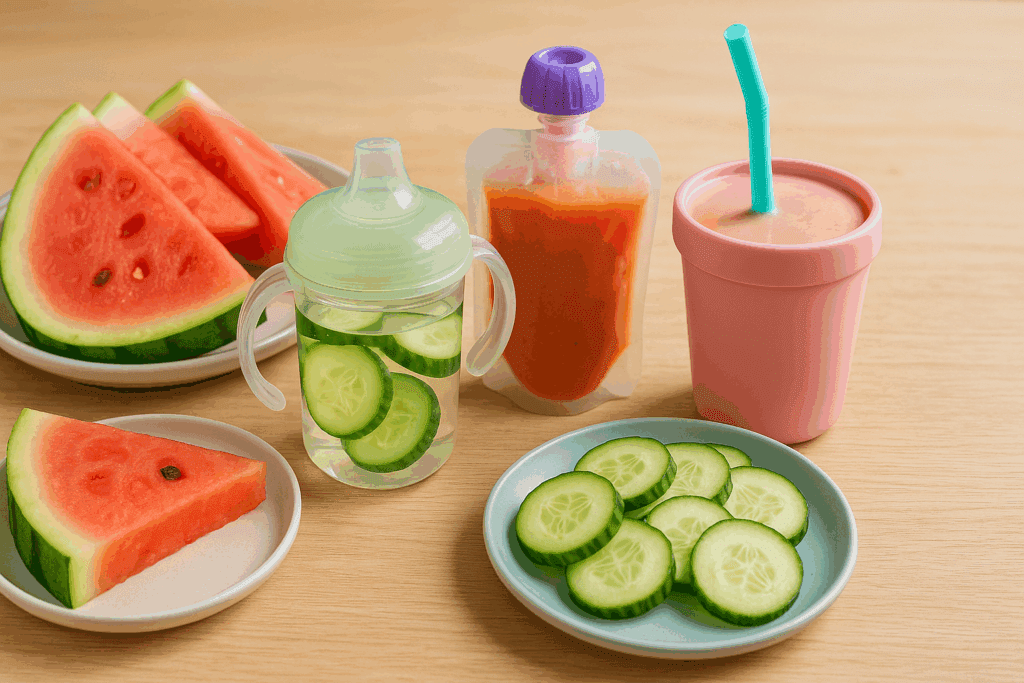
Combining Pouches with Other Healthy Hydration Strategies
While toddler pouches are a valuable tool, they should be integrated into a larger strategy that includes a variety of fluid sources. Water remains the gold standard for hydration, and children should be encouraged to drink from open cups, sippy cups, or straw cups as part of their daily routine. Introducing these skills early helps toddlers develop coordination, reduces dependency on pouches, and reinforces the concept that hydration is a normal, ongoing behavior.
In addition to water, whole fruits and water-rich vegetables like cucumber, watermelon, and oranges can significantly contribute to hydration. Homemade smoothies or diluted fruit juices (served in moderation and without added sugars) also provide hydration with the added benefit of fiber and antioxidants. Infused waters—such as a mix of strawberries and basil or cucumber and mint—offer sensory engagement and can appeal to children’s natural curiosity, encouraging them to explore hydration in creative ways.
Using pouches in tandem with these other methods allows for flexibility and variety. On days when appetite is low or the child is unwell, a hydrating pouch may be the most practical option. At other times, a colorful cup of ice water or a bowl of watermelon slices may suffice. The goal is not to rely solely on one delivery method, but to build a hydration toolkit that evolves with the child’s preferences and developmental stage.
Encouraging Healthy Beverage Habits from a Young Age
One of the most compelling reasons to invest in the best pouches for toddlers is their ability to support the development of lifelong hydration habits. Early exposure to unsweetened, nutritious beverages can shape taste preferences and reduce the likelihood of sugar dependency later in life. Pouches that prioritize natural ingredients and low sugar content subtly teach children that beverages don’t need to be overly sweet to be enjoyable.
Parents play a significant modeling role in this process. Children observe and often mimic adult behaviors, so caregivers who drink water regularly and express enjoyment in doing so reinforce the importance of hydration. Keeping healthy beverage options readily available and framing them as the default choice (rather than soda, juice boxes, or artificially flavored drinks) normalizes them in the child’s mind.
Establishing routines also helps. Offering a pouch or water cup after active play, before bed, or alongside meals can create consistent cues that promote hydration. Praise and positive reinforcement, such as celebrating when a toddler finishes a healthy drink or tries a new flavor, enhance motivation and strengthen the association between hydration and reward. When combined with age-appropriate education—like explaining how water helps their brain, muscles, or tummy feel good—children begin to internalize hydration as an essential part of self-care.
Pouches as Transitional Tools for Feeding Independence
Pouches not only offer practical hydration but also act as transitional tools that bridge the gap between dependent feeding and self-sufficient eating. For toddlers learning to grasp, squeeze, and sip independently, pouches provide a manageable, rewarding experience that fosters confidence. This transition is critical, as autonomy in eating supports fine motor skills, decision-making, and mealtime engagement.
The best baby pouches are designed with these developmental goals in mind. Features such as easy-grip bodies, flow-regulating spouts, and resealable caps accommodate a toddler’s learning curve while minimizing mess and frustration. Some brands even integrate educational games, color recognition, or animal themes into their packaging to promote interactive learning while the child eats or drinks.
Parents can support this learning process by gradually increasing the child’s responsibility during feeding times. For example, allowing the child to choose their pouch from a selection, helping them open the cap, or discussing the ingredients can turn a simple snack into an enriching activity. Over time, this empowerment extends to other mealtime behaviors, from using utensils to selecting food from a plate—further reinforcing the child’s agency and involvement in their own nutrition.
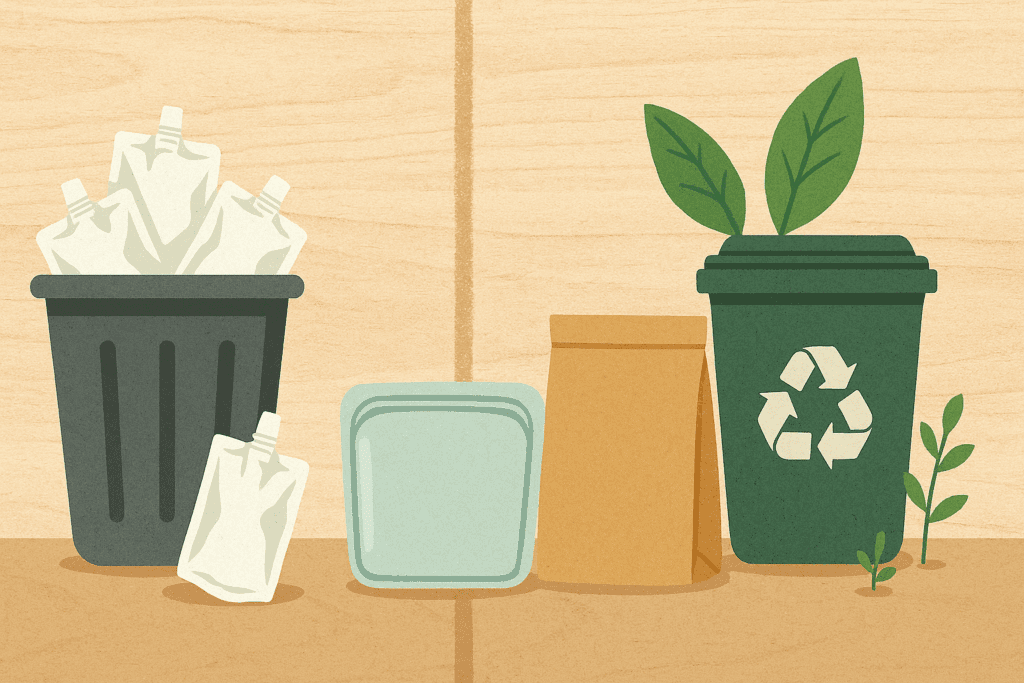
Environmental Impact and Ethical Considerations of Pouch Use
As the popularity of pouches continues to rise, so too does the conversation around their environmental impact. Traditional single-use pouches contribute to plastic waste, and while some brands have introduced recycling programs or compostable materials, these solutions are not yet universal. Parents concerned about sustainability must balance the convenience of pouches with their ecological footprint, making choices that align with both health and environmental values.
Fortunately, a growing number of companies now offer eco-friendly alternatives. Recyclable pouch programs, such as those partnered with TerraCycle, allow families to mail in used pouches for specialized processing. Reusable pouch systems made from food-grade silicone or biodegradable materials can be filled at home with smoothies, juices, or purees, offering the benefits of customization and waste reduction. These systems also empower parents to control every ingredient, which can be particularly valuable for children with dietary restrictions or allergies.
Ethical sourcing is another consideration. Parents may wish to support brands that prioritize fair trade practices, organic farming, and humane treatment of workers across the supply chain. Transparency about where ingredients are grown and how they are harvested reflects a brand’s commitment not only to quality but also to broader social responsibility. When parents choose the best pouches for toddlers based on both health and ethics, they help shape a more conscious and compassionate market.
Recognizing Signs of Dehydration and When to Use Pouches Therapeutically
Despite best efforts, there are times when toddlers may experience mild dehydration, especially during illnesses involving fever, vomiting, or diarrhea. Recognizing the early signs of dehydration—such as decreased urination, dry lips, lethargy, or sunken eyes—allows caregivers to respond quickly. In these cases, offering a hydrating pouch with electrolytes and a mild flavor can help restore fluid balance without overwhelming the child’s sensitive system.
Pouches can be particularly useful for children who refuse water or milk during illness. The familiar shape, taste, and ease of use may be comforting when energy is low and appetite is suppressed. Products that include coconut water or added electrolytes, like sodium and potassium, can be especially beneficial during recovery. However, parents should consult with a healthcare provider if symptoms persist, worsen, or are accompanied by high fever or unusual drowsiness.
It’s important to distinguish between therapeutic and everyday use. While pouches can serve as an effective hydration tool during times of illness or stress, they should not become a replacement for medical care or a substitute for balanced, whole-food nutrition. Used wisely and within context, the best baby pouches can act as a bridge during periods of vulnerability, offering gentle support while the child’s body heals and rehydrates.
The Future of Toddler Pouches: Innovation and Emerging Trends
The toddler pouch market is dynamic, with new innovations continually reshaping what’s possible in terms of nutrition, packaging, and functionality. One emerging trend is the integration of functional ingredients aimed at supporting immunity, digestion, and even cognition. Ingredients like probiotics, prebiotic fibers, omega-3s, and adaptogens are making their way into formulations, although their use in young children must be backed by clinical safety data and discussed with pediatric experts.
Another trend is the increased focus on personalization. Some companies are developing AI-driven quizzes or mobile apps that recommend pouch combinations based on a child’s age, dietary needs, or flavor preferences. Others allow parents to build custom subscription boxes with rotating flavor profiles or seasonal ingredients, enhancing variety while reducing decision fatigue.
Sustainability remains at the forefront of innovation as well. Bio-based plastics, edible packaging, and carbon-neutral manufacturing are all areas of development that promise to reduce the ecological cost of convenience. Brands that lead with both health and environmental stewardship are likely to gain traction among discerning parents seeking the best pouches for toddlers in a holistic sense.
The emphasis on transparency is also expected to grow. Smart labels with QR codes may soon allow parents to trace every ingredient’s origin, view batch-specific testing results, or access video tours of manufacturing facilities. These advancements will further strengthen the trust between families and the brands they rely on, reinforcing the importance of EEAT principles—Experience, Expertise, Authoritativeness, and Trustworthiness—in health-related consumer decisions.
Frequently Asked Questions About the Best Pouches for Toddlers
How can parents balance homemade options with the best pouches for toddlers?
While the convenience of store-bought pouches is undeniable, many parents also enjoy preparing homemade alternatives to control ingredients and reduce packaging waste. A great way to strike a balance is by reserving store-bought pouches for travel, daycare, or emergency use while using reusable silicone pouches at home. This approach not only introduces variety but allows parents to incorporate seasonal produce or tailor recipes to their child’s preferences and allergies. Homemade options can feature blends of vegetables, fruits, seeds, and even herbs like mint or basil for extra flavor exposure. By rotating between the best pouches for toddlers and DIY creations, families can encourage healthy eating habits and diversify nutrient intake without sacrificing convenience.
What role do cultural preferences play in choosing the best baby pouches?
Cultural traditions influence taste preferences, ingredient familiarity, and expectations around feeding practices. For example, families from Mediterranean backgrounds might favor pouches containing olive oil, chickpeas, or figs, while Asian families might seek options with mango, lychee, or even ginger. Many of the best baby pouches are now incorporating globally inspired flavors to reflect and respect cultural diversity, making it easier for children to enjoy foods that resonate with their heritage. This exposure can support early palate development and reduce food neophobia in later stages. By choosing pouches aligned with cultural values, parents can help preserve food identity while supporting hydration and nutrition.
Are there psychological benefits to toddlers using pouches independently?
Encouraging toddlers to drink from pouches on their own can boost self-esteem, autonomy, and confidence. The action of gripping, squeezing, and controlling the flow of liquid reinforces fine motor coordination while offering a rewarding sense of mastery. When toddlers are trusted to manage their own hydration tools, it sends a subtle but powerful message of trust and capability. This type of independence, especially when supported in positive environments, contributes to emotional resilience and self-regulation. Choosing the best pouches for toddlers with features like easy-open caps and spill-proof spouts reinforces these developmental opportunities while promoting stress-free hydration.
What innovations are emerging in the best pouches for toddlers?
Innovation in the toddler pouch industry is expanding rapidly, with some brands experimenting with smart packaging that changes color based on temperature or freshness. Others are using blockchain technology to provide full ingredient traceability through QR codes parents can scan with their phones. Functional ingredients—like marine-sourced omega-3s or plant-based adaptogens—are also being tested in toddler-safe quantities. Additionally, new pouch designs emphasize ergonomic comfort, with angled spouts or tactile elements that promote sensory engagement. These forward-thinking additions aim to elevate both the safety and educational value of the best pouches for toddlers while meeting evolving consumer expectations.
How do environmental factors influence a toddler’s hydration needs?
Factors like climate, altitude, and indoor temperature can significantly impact how much hydration a toddler needs on any given day. Hot or dry environments increase fluid loss through sweat, while cold climates can reduce thirst cues even when hydration is still necessary. High altitudes may also lead to quicker dehydration due to increased respiratory fluid loss. In such conditions, keeping the best baby pouches on hand—especially those that include electrolyte-rich ingredients like coconut water—can provide a reliable source of fluid replenishment. Parents should pay close attention to signs like fewer wet diapers, chapped lips, or increased irritability, which may indicate hidden dehydration.
Are pouches appropriate for toddlers with oral sensory issues?
For toddlers with oral motor challenges or sensory processing differences, traditional hydration methods may be difficult or stressful. Pouches can provide a gentler, more controlled alternative that aligns with their sensory needs. The predictable texture and regulated flow of the best pouches for toddlers can reduce overwhelm and make drinking more approachable. Some occupational therapists even recommend pouches as part of sensory feeding therapies, especially when working to desensitize children to textures or enhance oral muscle tone. With guidance from a specialist, pouches can serve as both a hydration tool and therapeutic aid, supporting developmental goals in a way that feels safe and familiar to the child.
Can the best baby pouches support gut health in toddlers?
Yes, several high-quality baby pouches now include prebiotic fibers like inulin or chicory root, which help feed beneficial gut bacteria. Others incorporate mild probiotic strains such as Lactobacillus rhamnosus or Bifidobacterium lactis, known to support digestive and immune function in young children. When combined with fiber-rich fruits or whole grains, these pouches contribute to a more balanced gut microbiome. It’s important, however, to ensure that any probiotic inclusions are specifically tested for toddler safety and are present in clinically relevant amounts. When selecting the best baby pouches for gut support, parents should look for third-party testing or pediatric endorsements for added peace of mind.
How do sleep patterns affect hydration strategies for toddlers?
Sleep and hydration are closely linked, particularly in toddlers whose fluid needs vary based on nighttime diaper output, ambient bedroom temperatures, and daily activity levels. Dehydration can lead to nighttime restlessness, early waking, or difficulty falling asleep. To counter this, offering a pouch with a balanced blend of electrolytes and minimal sugar about an hour before bedtime may help support overnight hydration without stimulating the bladder excessively. Morning pouches are also effective for rehydrating after a full night’s sleep, especially if toddlers are not inclined to drink water first thing. Choosing the best pouches for toddlers based on their sleep-wake cycles can help regulate mood, energy, and focus throughout the day.
How do social settings impact a toddler’s pouch consumption habits?
Social environments such as daycare, playgroups, or family gatherings can influence how and when toddlers use pouches. Children often model the behavior of peers, so if others are enjoying their pouches, a hesitant toddler may become more willing to try or finish one. On the other hand, toddlers might become distracted in busy environments and fail to drink enough fluids unless prompted. In such cases, offering one of the best pouches for toddlers—especially those with visually engaging packaging—can recapture attention and encourage better fluid intake. Caregivers should monitor these patterns and use social settings as opportunities to reinforce positive hydration habits through peer influence and encouragement.
Long-Term Wellness: Why Investing in the Best Pouches for Toddlers Matters
Although pouches are often seen as short-term feeding solutions, their influence can extend well beyond toddlerhood. Early exposure to balanced hydration options and nutrient-rich beverages sets the tone for how children approach food and drink choices in later life. The best pouches for toddlers act as building blocks for understanding portion control, self-care, and the pleasure of nourishing one’s body. When selected with intention and used in a thoughtful, varied diet, these pouches can foster lifelong habits around wellness and mindful consumption. As today’s toddlers become tomorrow’s independent eaters, the values instilled through consistent, high-quality nutrition experiences will shape their future health and relationships with food.
Conclusion: Final Thoughts: Choosing the Best Pouches for Toddlers to Promote Lifelong Hydration
In the journey of early childhood nutrition, choosing the best pouches for toddlers represents more than a product decision—it reflects a parenting philosophy rooted in intentionality, awareness, and care. Pouches that prioritize hydration, ingredient transparency, balanced nutrition, and developmental support offer families a powerful tool for maintaining wellness in both everyday routines and more vulnerable moments.
By understanding what constitutes a high-quality pouch—whether it’s the base ingredients, the sugar content, the flavor profile, or the packaging design—parents equip themselves to make choices that serve their child’s needs today while laying the foundation for a healthy tomorrow. These decisions also carry broader implications, encouraging sustainability, ethical consumption, and positive modeling behaviors that children will carry into adolescence and adulthood.
Ultimately, while the pouch may be small, its impact can be far-reaching. Whether tucked into a diaper bag or enjoyed during a quiet afternoon at home, the best baby pouches and toddler hydration solutions are those that honor the complexity of growing bodies and the values of thoughtful caregivers. With the right knowledge, trusted products, and a commitment to well-rounded wellness, parents can confidently support their child’s hydration journey—one delicious, nutrient-rich sip at a time.
Further Reading:
Best Pouches for Toddlers: Top Picks for Mess-Free Snacking
Best Baby Food Pouches (2025 Guide)
The Best Baby Food Pouches With Functional Ingredients – Expert Picks From a Pediatric Dietitian


